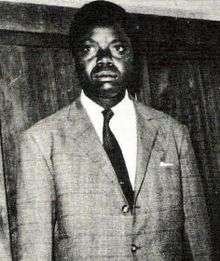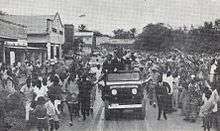Moïse Tshombe
Moïse Kapend Tshombe (sometimes written Tshombé) (10 November 1919 – 29 June 1969) was a Congolese businessman and politician. He served as the president of the secessionist State of Katanga from 1960 to 1963 and as prime minister of the Democratic Republic of the Congo from 1964 to 1965.
Moïse Tshombe | |
|---|---|
_-_53Fi5440_(cropped).jpg) Tshombe in France, 1963 | |
| 5th Prime Minister of the Democratic Republic of the Congo | |
| In office 10 July 1964 – 13 October 1965 | |
| President | Joseph Kasa-Vubu |
| Preceded by | Cyrille Adoula |
| Succeeded by | Évariste Kimba |
| Personal details | |
| Born | 10 November 1919 Musumba, Belgian Congo (Now Congo-Kinshasa) |
| Died | 29 June 1969 (aged 49) Algiers, Algeria |
| Political party | CONAKAT |
Early life
A member of the Lunda tribes, Tshombe was born near Musumba, Belgian Congo, the son of a successful businessman. He received his education from an American missionary school and later trained as an accountant. In the 1950s, he took over a chain of stores in Katanga Province and became involved in politics.
Political career
Along with Godefroid Munongo, he founded the Confédération des associations tribales du Katanga (CONAKAT) party. CONAKAT promoted a federal Congo independent of the Belgian colonial empire.[1]
President of Katanga
CONAKAT won control of the Katanga provincial legislature in the May 1960 general elections. One month later the Congo became an independent republic. Tshombe became President of the autonomous province of Katanga.[2] Patrice Lumumba was tasked with forming a national government. Members of his party, the Mouvement National Congolais, were given charge of the portfolios of national defence and interior, despite Tshombe's objections.[3] The portfolio for economic affairs was awarded to a CONAKAT member, but this was undercut by the positioning of nationalists in control of the Ministry and Secretariat for Economic Coordination. Mines and land affairs were placed under separate portfolios. Tshombe declared that this diluting of CONAKAT's influence rendered his agreement to support the government "null and void".[4]
On the evening of 11 July, Tshombe, accusing the central government of communist leanings and dictatorial rule, announced that Katanga was seceding from the Congo.[5] Favoring continued ties with Belgium, he asked the Belgian government to send military officers to recruit and train a Katangese army.

Tshombe demanded United Nations recognition for independent Katanga, and he announced that any intervention by UN troops would be met with force.[6] Nonetheless, Congolese Prime Minister Patrice Lumumba and his successor, Cyrille Adoula, successfully requested intervention from UN forces. UN forces were sent under the direction of UN Secretary-General Dag Hammarskjöld.
France, wishing to take advantage of Katangese minerals, sent to Tshombe the reinforcement of the mercenary Bob Denard and his men. It was supported by the networks of Jacques Foccart, the "Mr. Africa" of the French government.[7]
Lumumba's government was dissolved, and Lumumba taken prisoner by Mobutu and detained at Camp Hardy in Thysville. Harold Charles d'Aspremont Lynden (Belgian minister for African Affairs) sent a highly confidential telegram on 16 January 1961 to the government in Léopoldville (President Joseph Kasa-Vubu and Mobutu) to send Lumumba to Katanga. That would have stemmed from Lumumba's increasing popularity among soldiers, who might release him. Meanwhile, soldier mutinies and unrest increased by the day, at Prison Camp Hardy in Thysville. The telegram has still not been shown to exist.
Whilst being flown in a Sabena Douglas DC-4 plane to Katanga, Lumumba was beaten by the Congolese soldiers escorting him. In custody in Katanga, Lumumba was visited by Katangese notables and Belgian officers, who included Tshombe, Godefroid Munongo, Kibwe, Kitenge, Grandelet, Son, Gat, Huyghé, Tignée, Verscheure, Segers and Rougefort. Lumumba's execution, on 17 January, was carried out by a firing squad led by a Belgian mercenary, Julien Gat.[8]
Prime Minister of the Congo

In 1963, UN forces succeeded in suppressing Katanga, driving Tshombe into exile in Northern Rhodesia, later to Spain. In July 1964, he returned to the Congo to serve as prime minister in a new coalition government. His cabinet was sworn in on 10 July.[9] Tshombe's national support was derived from the backing of provincial political bosses, customary chiefs, and foreign financial interests.[10] Among his first acts in office were the lifting of a curfew in Léopoldville, the release of 600 political prisoners—including Antoine Gizenga, and the ordering of Katangese gendarmes to return from their exile in Angola to the Congo and join the national army.[9] In a New Year's message at the beginning of 1965, Tshombe rejected conciliation with the Simba rebels and called for their total defeat.[11] He was dismissed from his position in October 1965 by President Kasa-Vubu. In November, General Mobutu, who had staged a successful coup against Kasa-Vubu, brought charges of treason against Tshombe, who again fled the country and settled in Francoist Spain.
Later life
In 1967, Tshombe was sentenced to death in absentia. On 30 June 1967, he was in a Hawker Siddeley jet aircraft that was hijacked by Francis Bodenan, an agent of the SDECE of France. According to the Congolese government, Tshombe was going to Africa.[12]
Tshombe was taken to Algeria, jailed, and placed under house arrest. The pilots of the plane, Britons Trevor Coppleston and David Taylor, were released and returned to the United Kingdom. The Congolese government demanded his extradition to Congo, and his Western supporters agitated for his release.[12] The Algerians resisted both demands. A part of his supporters gathered to form the Tshombe Emergency Committee in the U.S., including Marvin Liebman and William F. Buckley, to press for his release and move to Spain.[13] Long-time aide Michel Struelens travelled to different European cities to lobby for Tshombe, eventually to no avail.[14]
Death and legacy
"Moïse Tshombe nearly became the 'savior' of the Congo on his return from exile. But history decided otherwise, and the Congolese people found themselves under the leadership of Mobutu".
Tshombe died in 1969; the official cause of death was listed as "death from heart failure." He was buried in a Methodist service at Etterbeek Cemetery, near Brussels, Belgium.[16] Owing to his role in the death of Lumumba and his association with Western interests, Tshombe's surname to black African nationalists became synonymous with "sellout".[17][18][lower-alpha 1]
The plot of the 1978 war film The Wild Geese is based in part on speculation that Tshombe's plane had initially been diverted to Rhodesia before being sent to Algeria. The film's characters Col. Allen Faulkner and President Julius Limbani were largely based on Tshombe and his military ally Maj. "Mad Mike" Hoare.[20]
Honours
- Knight Grand Cross of the Order of the Crown.[21]
Notes
- A derivative of Tshombe's name, chombe, was incorporated into the Shona language as a word for "sellout". Kuchomba is the verb form.[19]
Citations
- The Congo from Leopold to Kabila, Georges Nzongola-Ntalaja, 2002, ISBN 1-84277-053-5, accessed February 2009
- "Congo (Kinshasa) provinces". www.rulers.org. Retrieved 17 September 2017.
- Hoskyns 1965, p. 79.
- Gérard-Libois 1966, p. 85.
- Hoskyns 1965, p. 99.
- "Katanga Premier Warns U.N. Force" (PDF). The New York Times. Reuters. 21 July 1960. Retrieved 10 January 2016.
- https://journals.openedition.org/ccrh/512
- The Assassination of Lumumba, Ludo De Witte, 2003, ISBN 1-85984-410-3
- O'Ballance 1999, p. 70.
- Semonin 1968, p. 20.
- O'Ballance 1999, p. 85.
- Gibbs, David N. (1991). The Political Economy of Third World Intervention. University of Chicago Press. pp. 152, 167–168. ISBN 0-226-29071-9.
- Burke, Kyle (2018). Revolutionaries for the Right: Anticommunist Internationalism and Paramilitary Warfare in the Cold War. The University of North Carolina Press. p. 47. ISBN 9781469640730.
- Freiherr von Müllenheim-Rechberg, Burkard (1998). Entführung und Tod des Moïse Tshombe: Das Ende einer Hoffnung für den Kongo. LIT. pp. 72–73. ISBN 3-8258-3940-0.
- Kanza 1994, p. 327.
- "Tshombe is Buried in Brussels; Sons Weep at His Grave". The New York Times. UPI. 6 July 1969. p. 6. Retrieved 18 January 2016.
- Sibanda 2005, p. 116.
- Fouéré 2015, p. 158.
- Pekeshe, Munhamu (15 January 2015). "Tshombe, Geneva and détente in the village". The Patriot. Retrieved 15 May 2018.
- "Mercenary 'Mad Mike' Hoare dies aged 100," www.bbc.com, 3 February 2020. Retrieved 26 February 2020.
- Frankel, Benjamin (ed.), The Cold War, 1945-1991: Leaders and other important figures in the Soviet Union, Eastern Europe, China, and the Third World, p. 339
References
- Fouéré, Marie-Aude, ed. (2015). Remembering Julius Nyerere in Tanzania: History, Memory, Legacy (illustrated, reprint ed.). Mkuki na Nyota Publishers. ISBN 9789987753260.CS1 maint: ref=harv (link)
- Gérard-Libois, Jules (1966). Katanga Secession (translated ed.). Madison, WI: University of Wisconsin Press. OCLC 477435.CS1 maint: ref=harv (link)
- Hoskyns, Catherine (1965). The Congo Since Independence: January 1960 – December 1961. London: Oxford University Press. OCLC 414961.CS1 maint: ref=harv (link)
- Kanza, Thomas R. (1994). The Rise and Fall of Patrice Lumumba: Conflict in the Congo (expanded ed.). Rochester, VT: Schenkman Books, Inc. ISBN 0-87073-901-8.CS1 maint: ref=harv (link)
- O'Ballance, Edgar (1999). The Congo-Zaire Experience, 1960–98. Basingstoke, England: Palgrave Macmillan. ISBN 978-0-230-28648-1.CS1 maint: ref=harv (link)
- Semonin, Paul (January 1968). "Mobutu and the Congolese". The World Today. 24 (1): 20–29. JSTOR 40394031.CS1 maint: ref=harv (link)
- Sibanda, Eliakim M. (2005). The Zimbabwe African People's Union, 1961-87: A Political History of Insurgency in Southern Rhodesia (illustrated ed.). Africa World Press. ISBN 9781592212767.CS1 maint: ref=harv (link)
Further reading
- Colvin, Ian. The rise and fall of Moise Tshombe: A biography (Frewin, 1968).
- De Witte, Ludo (2003). The Assassination of Lumumba. Verso. ISBN 1-85984-410-3.
- Gibbs, David N. "Dag Hammarskjöld, the United Nations, and the Congo Crisis of 1960–1: a reinterpretation." Journal of Modern African Studies 31.1 (1993): 163-174. online
- Kalb, Madeleine G. The Congo cables: the cold war in Africa--from Eisenhower to Kennedy (1982).
- Mazrui, Ali A. "Moise Tshombe and the Arabs: 1960 to 1968." Race 10.3 (1969): 285-304.
- O'Brien, Conor Cruise. "The UN, Congo and Tshombe." Transition 15 (1964): 29-31. online
External links
| Political offices | ||
|---|---|---|
| Preceded by Cyrille Adoula |
Prime Minister of the Democratic Republic of the Congo 10 July 1964 – 13 October 1965 |
Succeeded by Évariste Kimba |